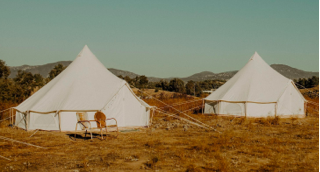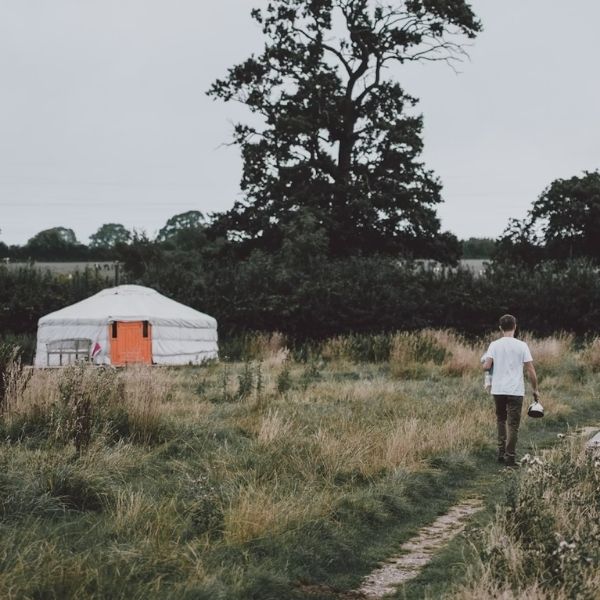PAY NO SALES TAX
Questions? CALL 971-220-8368
Free Shipping

Pay No Sales Tax
30-Month Warranty
PAY NO SALES TAX
Questions? CALL 971-220-8368
Tents
Shop


The LiT List
Glamping & Camping Ideas + Resources
Fetch the Tent: Tips for Camping With Your Dog
5 min read
Curling up inside a camping tent with your dog has to be one of the best things about camping. And camping with your dog creates wonderful memories, strengthening your bond. It can also provide peace of mind and a sense of safety, especially for solo travelers. But if you’re hesitant or just not sure how Fido will handle it, here is a list of tips for camping with your dog to make it safe and stress-free.
Useful Tips for Camping With Your Dog

Get Your Dog Used to Being Outdoors
An obvious, but important tip! You might think your dog is already used to being outdoors because you take them on daily walks to local parks. But heading deeper into the wilderness? It’s a whole different scenario. Even well-trained dogs get overstimulated by the sights, smells and sounds of nature, so being aware of how they might react before camping and sleeping overnight is crucial.
Practice your dog’s recall and commands, ideally at a crowded park or a new environment, ensuring they listen and stick by you or come on call. When camping with your dog, this ensures they won’t bark at fellow campers walking by, charge at wildlife (risky in bear country), sniff suspicious plants, or chomp down on questionable mushrooms.
Choose a Pet-Friendly Campground
Choose your campground wisely. Camping and dogs don’t always go hand in hand. Some campgrounds restrict pets (for the safety of you, your dog, and local wildlife), so mind the rules and choose a dog-friendly campground.
And read the campground pet policy! While some allow dogs at sites, they may restrict them in other areas like trails (disappointing if you’d planned to take a hike together). And some campgrounds require dogs to be leashed at all times, sometimes specifying the leash length too.
Introduce Your Dog to a Camping Tent
Give your dog time to get familiar with camping tents. Go camping in your backyard overnight if possible. If not, aim to find a campground close to home (just in case things go sideways). This will not only get your dog used to camping in a tent, but help you learn how they react overnight in one, and help you anticipate things that can go wrong (like barking at every little noise or escaping the tent – tips on that below).
Update Your Dog’s ID and Vaccination Records
Make sure all of your dog’s identification and vaccines are current and up-to-date. Most campgrounds require proof of vaccinations, not to mention it’s plain safe and healthy for your dog in case they run off or come into contact with other animals.
Here’s a helpful rundown:
- Identification, including collar tags and/or microchips
- Rabies and Lyme vaccinations
- Heartworm prevention
- Flea prevention
Build and Bring a Pet First Aid Kit
Anytime you go camping, pack a first aid kit for yourself and for your dog. While there are many first aid items families can share, others are more helpful for your furry family members.
- Antiseptic wash
- Neosporin Gauze, bandages or sports tape
- Paw palm for cracked paws
- Tramadol/Gabapentin (vet prescribed)
- Tweezers or Tick Key
And always research pet hospitals or veterinary clinics local to your campground – just in case!
Pack Enough Dog Food, Water and Treats
Pack enough dog food, treats, and water (if not available at the campground). Bring extra dog food to sustain them throughout the day and after hikes. Bring their food bowl, but be cautious and mindful that it might also attract wildlife and pests, and keep their food secure at night.
Also, make sure they stay hydrated. The excitement and stimulation can be a lot for some dogs – even well-trained dogs – so encourage them to drink when you can. Collapsible food bowls are perfect for carrying from site to trail.
Make Your Camping Tent More Dog-Friendly

Your camping tent is your home away from home, so make sure it feels comfortable and secure for your dog, too. Bring their dog bed, maybe even an old one you don’t mind getting dirty at camp. And, in general, create a more dog-friendly camping tent.
Here are some tips and setup ideas:
- Bedding: Dogs have double coats built for cold weather, but it's important to give them somewhere to burrow and curl up at night, like a dog bed, dog blankets, or cheap moving blankets, for extra insulation and protection from the cold, hard ground.
- Closed-cell foam pads: Lend extra insulation and a nail-resistant layer. It’s always recommended to trim your dog’s nails before camping to minimize damage to your tent floor. But you can also roll out a durable rug or mat inside the tent, too.
- Portable dog crate: If your pup feels more comfortable and it’s their safe space, consider bringing their crate. Leave the door open so they can come and go as they please.
- Zip the tent at the top. If your dog can manage to get their snout past zippers and escape, zip the tent up so the zippers are at the top.
- Pack a dust pan and broom:To remove tracked-in dirt and dog hair.
Cosleeping with your pup lends extra body heat for you, but if you prefer to protect nice camp gear, a proper camp dog bed encourages your pup to sleep separately. The more warm and comfortable you make their bed, the less likely they will curl up in bed with you.
Beat the Zoomies With Exercise
Provide your dog plenty of exercise, so that they rest back at the campsite and sleep throughout the night. This goes double for high-energy dog breeds!
Take them on daily hikes or to an open space where you can play fetch. And then, back at the site, bring a tie out, crate, or coral, allowing them space to roam (without always being underfoot). Some seasoned campers recommend tying out in the back of your campsite so that your dog doesn’t disturb passing neighbors.
Reduce Nighttime Barking With White Noise
Dogs can become vigilant at night, especially inside the tent. Light sleepers who bark at any snapping twig or scurrying critter will keep everyone from getting good sleep. So do your pup and yourself a favor and cancel out the noise with something else.
For first-time camping dogs, a noise machine is practical. While it’s not typically something you’d consider packing for camping trips, a noise machine cancels sounds, keeping your dog distracted so they don’t bark at night. A small portable camp fan does the trick, too. Plus, it keeps your tent cool, especially during those hot and humid nights.
Be Vigilant and Keep Track of Your Dog
When camping, it’s important to keep a close eye on your dog and never leave them unattended. But even obedient dogs get curious and wander off. So, aside from keeping their collar on (a must!), make it easier to track them by adding a collar light, bell, GPS tracking device, or a non-subscription-based AirTag or Tile tracker.
Fetch the Tent and Take Your Dog Camping

Dogs make great fireside company, lend body heat beneath the covers, and, of course, bring joy to every step of the trail. We hope these tips help inspire and prepare you for an outdoor adventure with your dog, because there’s nothing better than sharing a tent with your most loyal friend.
Related Resources

THE LIT LIST 4 min read
Valentines Day Gifts For Camping and Campers
Buying a valentines day gift for your loved one should be fun, not stressful! (and not everyone want
THE LIT LIST 4 min read
What Is a Yurt Tent?
If you want a bohemian backyard retreat or a romantic glamping weekend, a yurt tent could be just whWhat is a yurt shaped tent? Explore how traditional yurts have evolved and learn the different styles of modern yurt tents used for glamping today.
Popular Blogs
Camping Gift Ideas for People Who Have Everything
The Best Portable Tent Heaters - Ways To Heat A Canvas Tent
Glamping in Northern California: 8 Luxury Sites
Waterproofing A Canvas Tent - Retreating Canvas
33 Camping Quotes to Inspire Your Next Adventure
What Is Glamping? Origins, Definition, Destinations & More
10 Tips for Staying Warm While Winter Camping
How to Maintain and Clean a Bell Tent
Essential Family Camping Checklist: What to Pack [PRINTABLE]
Backyard Glamping Checklist for an Unforgettable DIY Glampsite
Popular Products
Subscribe
Sign up to get the latest on sales, new releases and tips
BECOME AN INSIDER
We’ll periodically share inspiration, bell tent releases, special offers, and event notifications with ya.



